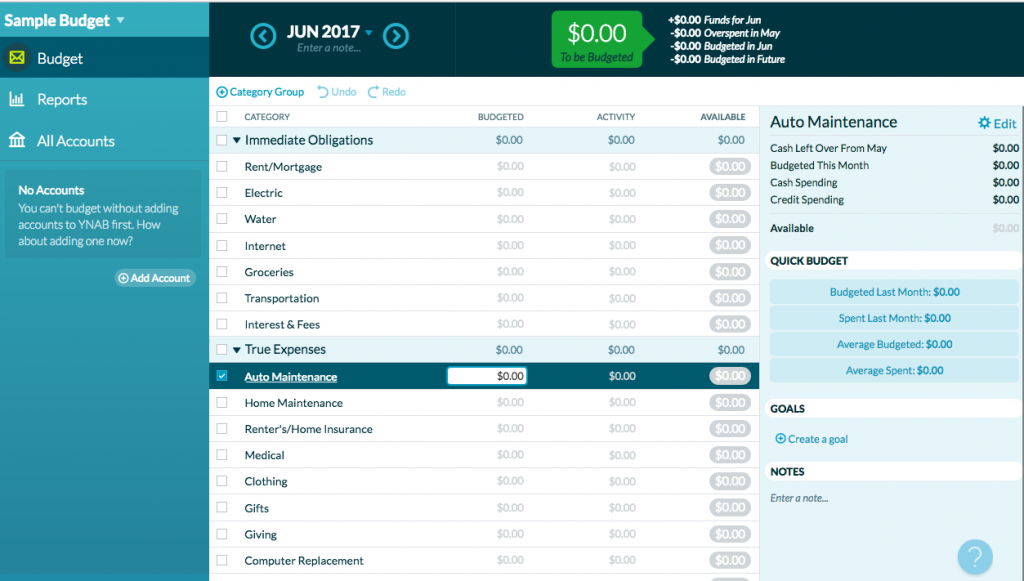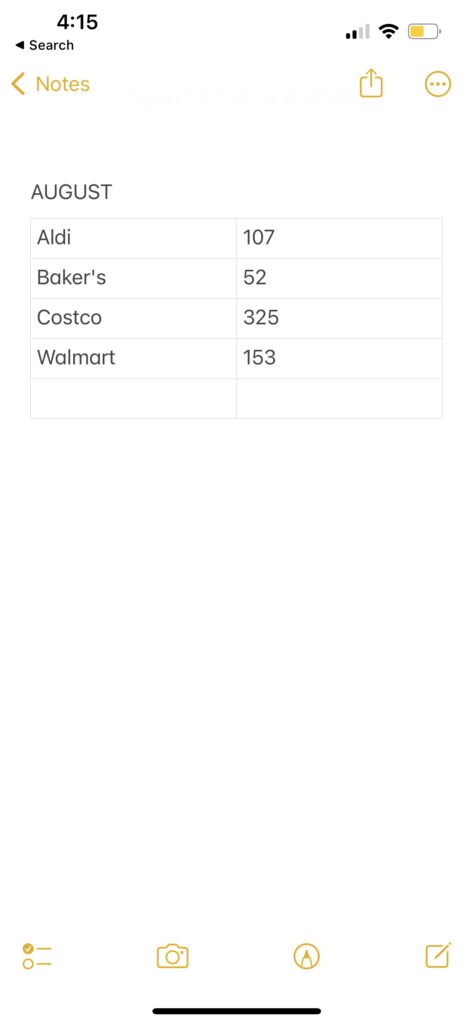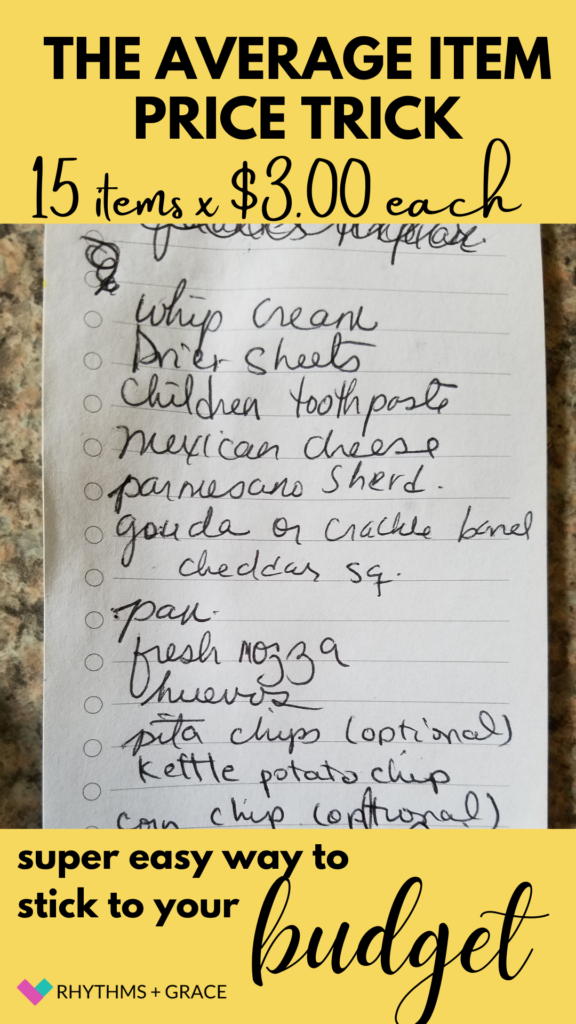Some of the links on this page are affiliate links. When you make a purchase through an affiliate link, I earn a commission at no cost to you. See my entire disclosure policy for all the boring details.
I’ve been using this simple grocery budget tracking method for years!! It’s legitimately useful while you’re actually in the store, shopping around. (And no, you don’t need a calculator to add up every single price.)
The gist of my grocery budget hack is this:
Figure out the average per item for the store you’re heading to. Count the items as you put them in your cart & multiply by the average price per item for that store.
Seriously, it’s that simple. I’ve been doing it for YEARS. It’s absolutely one of the easiest ways to stick to your grocery budget.
This post will spell out the details of my method AND ideas for using this trick in combination with other grocery savings ideas so you can save extra money on your monthly grocery budget.
How Can Something So Easy Really Work?
I first started using this method when we joined Costco. As a growing family of 4 kids, I knew we could consume the food quantity and get the benefit of the bulk pricing, but oh my word… I did NOT know how to budget for Costco. Throw a handful of things in my cart and it’d be $300! (And this was back in 2018.)
Then one day I realized it said the number of items on the bottom of my receipt. And the price was average of $10 per item.
I wonder if it’s always $10 per item?
So I started counting items at Costco. Sure enough. The price was always pretty darn close to $10 average per item… no matter what I bought. It was crazy. (Again, this was 2018. In 2023, I have to use $14 per item at Costco. We’re in the Midwest. Obviously, prices will vary based on your location.)
I wonder if this works at every store.
Yep! Yep, it does.
In 2023, my current Aldi price per item is about $2.50. This trick works for most of my local grocery store chains too.

I will say… the only place I’ve had a hard time nailing down price per item is Walmart. I use Walmart pickup, so I order online and it’s a little easier to just stick to your budget when you’re seeing the total add up as you go anyway.
For the sake of this article, though, I went into my purchase history in the Walmart app. I use Walmart Pay in the store too, so it’s easy to go into my Walmart app and see how much each purchase was and how many items I bought. The average price per item was usually around $2.75. There were a few times it was closer to $6.00. (On all the receipts where my average was closer to $6.00, I had purchased formula or diapers for an extra baby we watch sometimes, which I don’t buy very often anymore.) I ended up deciding my Walmart average would be $3.00 per item, for easy math & conservative rounding.
Grocery List or No Grocery List
Yeah, yeah, yeah. Every single grocery savings post tells you to make a grocery list. And I almost always shop with one. It might be the most important thing you can do to stick to a weekly grocery budget.
BUT – if you hate using a shopping list, you can still use this average price method to stick to your grocery budget!! Just count the items as you go and adjust what you buy according to your overall budget you’re trying to stick to.
Use the Average Price Trick WITH a List
If you do make a grocery list, you can actually ballpark the price of the whole shopping trip BEFORE you even go to the store, while you’re at home meal planning & list making. Just count the items on your list and see if it fits your grocery budget. If you’re under budget by a lot, maybe you can add some healthy snacks or a fun treat. Or double one recipe and pop it in the freezer for a day you don’t feel like cooking. This type of planning helps me stay away from impulse buys & save lots of money in the long run. Plus I like to plan meals around what we have on hand so that we waste less & save more.
If you’re over-budget before you go, rework your meal plan. Do you have any food on hand you can use to simplify your shopping list this week? You could also check the local ads to see what the best prices are on fresh produce and choose fresh fruits and food items that are on sale that week. By choosing sale items, you’ll bring your price per item down!
Use the Average Price Trick WITHOUT a List
Actually, a great way to save money on name brands items or meat is to shop the super duper sales & loss leaders at your local stores. One store of ours puts meat that is almost expired on clearance. If you snag it and use it that night or put it in the freezer, you can save a lot of money.
You can check the ads before you go and meal plan around those, or if you’re a frugal super shopper, you can just go to the store and only buy the really well priced items.
Either way, you can count the items and use the average price method to stick to your budget.
But, How Much is In My Budget?
There is one caveat to this method… you have to know how much money is in your grocery budget. Maybe this seems obvious!? But it’s hard to stick to a budget if you don’t have a budget. And most people I know in real life do not know how much money they spend on groceries in a given month.
Because they don’t track it.
If you don’t track grocery spending, it’s hard to know what a realistic grocery bill is for you. And if you try to guess, you’ll likely be way off and discouraged.
I hate to break it to you, but you probably have to figure out a way to track your grocery spending if you want to stick to a budget. (Actually, I don’t hate to break it to you. Because learning to budget was the best thing ever for our family finances & our marriage!)
The 3 best options for tracking your grocery spending are:
- Cash – put your entire budget in an envelope for a month and spend out of there. Only. Cash doesn’t lie. Plus you’ll spend less if you spend in cash… guaranteed!
- YNAB – this is what we use to track all our spending. YNAB is essentially fancy digital envelopes. You take a certain amount of money & assign it into the groceries category. Whenever you spend money at a grocery store, you tell YNAB that purchase should be categorized as groceries. It automatically deducts the money from your grocery budget for you and tells you how much you have left.
- Empty envelope – this idea comes from Jordan Paige. You write down your spending on an envelope as if there was cash in there, but you actually use your debit card.
- Spreadsheet – for you spreadsheet nerds out there!
This post explains more details about methods for tracking grocery spending.

How Much Do I Need to Spend on Groceries?
The core of my average-price method is simple, but if you have no clue how much money your family currently spends on groceries, you’ll probably have to do a couple months of leg work.
I promise it will be 100% worth it though!!
If you’re brand new to grocery budgeting, just start writing down what you spend on groceries and household products. Every single trip! A note in your phone is probably simplest. This is hands down the best starting point and an easy way to pay attention to what you spend.

If it sounds overwhelming, it’s not that hard! Ignorance is not bliss. If you start writing down what you spend, you will be able to save money and change spending habits as you decide to. It really is that simple.
Add it up at the end of each week and month for a couple months. There – that’s your grocery budget. Embrace it. However much you spend on food is how much you currently need to budget for food spending.
If you want to cut that number down or need to get on a tight budget, you need a PLAN. I would try one money-saving hack at a time and try to cut your budget by 10% at first. Then you can cut another 10% and so forth.
You could also take the go-big-or-go-home approach. If you feel like your spending is out of control or you are in a desperate situation, then go crazy. Cut it in half. Eat beans and rice. Spend as little as possible. (We did this for a while to pay off student loan debt!)
Some ways to save money on groceries are:
- Meal planning – especially planning meals that use food you already have on hand. Less food waste & more savings.
- Menu planning matrix – taco tuesday, crockpot wednesday, pot roast thursday, etc. Some sort of organized system that allows you to cook simple meals and removes some of the decision making. I use a system like this for breakfast, lunch & dinner these days! (All 6 of us eat all 3 meals at home now.)
- Scan local ads online for the best deals and learn the food prices at a couple stores.
- Aldi – it’s definitely the lowest price per item!! Here are all the reasons I love Aldi.
- Buy store brands whenever possible.
- Only shop at a discount store like Costco or Sam’s Club if you can figure out how to control the volume you purchase. If it’s too expensive, just don’t go!
- Buy seasonal fruits at a local farmers market or choose the cheapest produce to plan around that week.
- Minimize ready-made foods. If these are a huge part of your life now, you can gradually start meal prepping and getting ahead with making your own convenience meals. I always have a Costco frozen convenience meal in the freezer, but also plan to cook most days. If something comes up, we have a backup and don’t need takeout. If you use pre-made meals a lot right now, I’d start by just trying to cut one night per week where you plan ahead. Search “crock pot dump meals” for recipe ideas. That’s as close to homemade convenience as it gets! And if you double the recipe, you can eat for a couple days.
- Have a list of easy meals that anyone in your household could make and that you generally have food on hand for – grilled cheese, cans of tomato soup, beans & rice & cheese quesadillas, and the classic… peanut butter and jelly.
What is Realistic for a Family of 4? 5? 6? 10?
Honestly, there are SO many things that go into how much your family’s individual budget might be… what type of food you eat, whether or not you source any meat or produce locally, how often you eat at home versus eat out, how many people are in your family, etc.
Our family of 6 eats 3 meals a day at home because we homeschool & my husband works from home. My grade school aged kids eat more than they did when they were toddlers, but we’re not yet feeding teens either! We snack on fresh produce, cheese, lunch meat, nuts, and occasionally popcorn or crackers. We eat healthy meals of lean meat & vegetables 5 days a week. I do supplement with rice & pasta sometimes. (I don’t cook Friday or Sunday evenings.) We don’t eat out much and I do include household products like paper plates, paper towels, toilet paper, etc. in this amount. (It’s too much work for me to separate out household products from groceries since I buy them at the same places.)
Every single one of those choices factors into our grocery spending. We pay higher prices for fresh produce in winter months because, but it’s a priority to us.
Recently, I’ve worked pretty darn hard at the grocery store to get our budget down from $1800 to $1500. We just needed to cut back and be more frugal and this was one area I could be more thrifty in. We go to Costco about once a month and get a handful of our regular favorites there, plus some snacks if the ones we like are on sale! This trip is usually around $400. (25-30 items in my cart.) Then, I try to stay under $200 for the rest of my weekly trips.
Aiming for $400 at Costco and $200/ week at Aldi, Walmart, or a local store leaves a little wiggle room for last minute forgotten item trips or special food for hosting.
Note: we’ve been budgeting pretty diligently since 2014 (almost 9 years as of writing this)!! My grocery budget back then with a baby and toddler was $450.

Don’t Buy Toilet Paper at the Grocery Store
Most household products are way overpriced at a grocery store, unless you’re at Walmart or Target or Costco. Costco’s Kirkland toilet paper is the cheapest, by far.
We don’t like Costco brand toilet paper. So, the cheapest way I have found to buy toilet paper is to wait until Target has a spend $75, get $15 gift card type sale on household products. I then order that much toilet paper to be shipped to my door. We like Target’s store brand toilet paper… up & up ultra strong. My husband is very opinionated about toilet paper…. TMI? Haha!
Our kids then take the toilet paper out of the packaging and put it all away in a closet or under-the-sink cabinet. This amount of toilet paper lasts MONTHS and it’s a good price.
Get a General Household Budget
YNAB is my #1 tool for household budgeting. We’ve tried everything out there, but YNAB far exceeds them all.
I only very recently discovered there is a YNAB book. It’s titled: You Need a Budget. (Shocking, I know.) I read it after being an avid YNAB user for 7+ years and I learned so much about the philosophy behind the software. It was perfect timing because the author (and creator of the software) explained how to budget on an irregular income like I’ve never heard before. It was perfect since my husband had just started a consulting business at the time and our income became extremely irregular.
All that to say – whether or not you’ve ever tried YNAB, if you don’t have a system that works for you, I highly recommend reading the book & then signing up for a free trial. It’s $99/ year ($8.25 a month) and we certainly save thousands of dollars a year using it. Best money we spend!!
Check out my full YNAB review here.

